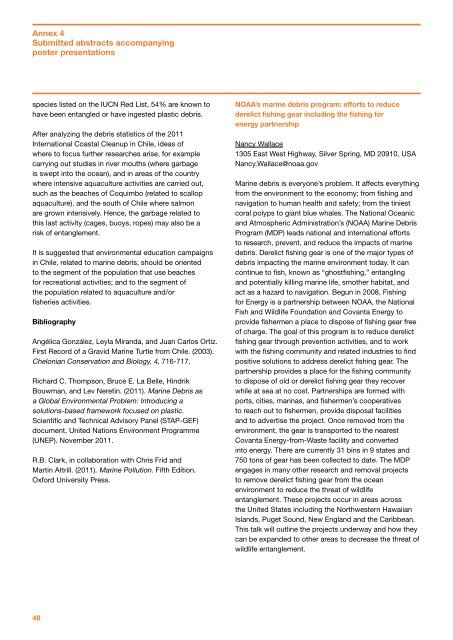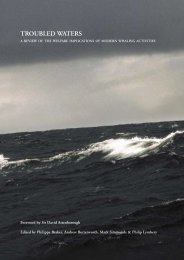Annex 4Submitted abstracts accompanyingposter presentationsspecies listed on <strong>the</strong> IUCN Red List, 54% are known tohave been entangled or have ingested plastic debris.After analyzing <strong>the</strong> debris statistics <strong>of</strong> <strong>the</strong> 2011International Coastal Cleanup in Chile, ideas <strong>of</strong>where to focus fur<strong>the</strong>r researches arise, for examplecarrying out studies in river mouths (where garbageis swept into <strong>the</strong> ocean), and in areas <strong>of</strong> <strong>the</strong> countrywhere intensive aquaculture activities are carried out,such as <strong>the</strong> beaches <strong>of</strong> Coquimbo (related to scallopaquaculture), and <strong>the</strong> south <strong>of</strong> Chile where salmonare grown intensively. Hence, <strong>the</strong> garbage related tothis last activity (cages, buoys, ropes) may also be arisk <strong>of</strong> entanglement.It is suggested that environmental education campaignsin Chile, related to marine debris, should be orientedto <strong>the</strong> segment <strong>of</strong> <strong>the</strong> population that use beachesfor recreational activities; and to <strong>the</strong> segment <strong>of</strong><strong>the</strong> population related to aquaculture and/orfisheries activities.BibliographyAngélica González, Leyla Miranda, and Juan Carlos Ortiz.First Record <strong>of</strong> a Gravid Marine Turtle from Chile. (2003).Chelonian Conservation and Biology, 4, 716-717.Richard C. Thompson, Bruce E. La Belle, HindrikBouwman, and Lev Neretin. (2011). Marine Debris asa Global Environmental Problem: Introducing asolutions-based framework focused on plastic.Scientific and Technical Advisory Panel (STAP-GEF)document, United Nations Environment Programme(UNEP). November 2011.R.B. Clark, in collaboration with Chris Frid andMartin Attrill. (2011). Marine Pollution. Fifth Edition.Oxford University Press.NOAA’s marine debris program: efforts to reducederelict fishing gear including <strong>the</strong> fishing forenergy partnershipNancy Wallace1305 East West Highway, Silver Spring, MD 20910, USANancy.Wallace@noaa.govMarine debris is everyone’s problem. It affects everythingfrom <strong>the</strong> environment to <strong>the</strong> economy; from fishing andnavigation to human health and safety; from <strong>the</strong> tiniestcoral polyps to giant blue whales. The National Oceanicand Atmospheric Administration’s (NOAA) Marine DebrisProgram (MDP) leads national and international effortsto research, prevent, and reduce <strong>the</strong> impacts <strong>of</strong> marinedebris. Derelict fishing gear is one <strong>of</strong> <strong>the</strong> major types <strong>of</strong>debris impacting <strong>the</strong> marine environment today. It cancontinue to fish, known as “ghostfishing,” entanglingand potentially killing marine life, smo<strong>the</strong>r habitat, andact as a hazard to navigation. Begun in 2008, Fishingfor Energy is a partnership between NOAA, <strong>the</strong> NationalFish and Wildlife Foundation and Covanta Energy toprovide fishermen a place to dispose <strong>of</strong> fishing gear free<strong>of</strong> charge. The goal <strong>of</strong> this program is to reduce derelictfishing gear through prevention activities, and to workwith <strong>the</strong> fishing community and related industries to findpositive solutions to address derelict fishing gear. Thepartnership provides a place for <strong>the</strong> fishing communityto dispose <strong>of</strong> old or derelict fishing gear <strong>the</strong>y recoverwhile at sea at no cost. Partnerships are formed withports, cities, marinas, and fishermen’s cooperativesto reach out to fishermen, provide disposal facilitiesand to advertise <strong>the</strong> project. Once removed from <strong>the</strong>environment, <strong>the</strong> gear is transported to <strong>the</strong> nearestCovanta Energy-from-Waste facility and convertedinto energy. There are currently 31 bins in 9 states and750 tons <strong>of</strong> gear has been collected to date. The MDPengages in many o<strong>the</strong>r research and removal projectsto remove derelict fishing gear from <strong>the</strong> oceanenvironment to reduce <strong>the</strong> threat <strong>of</strong> wildlifeentanglement. These projects occur in areas across<strong>the</strong> United States including <strong>the</strong> Northwestern HawaiianIslands, Puget Sound, New England and <strong>the</strong> Caribbean.This talk will outline <strong>the</strong> projects underway and how <strong>the</strong>ycan be expanded to o<strong>the</strong>r areas to decrease <strong>the</strong> threat <strong>of</strong>wildlife entanglement.48
Annex 4Submitted abstracts accompanyingposter presentations3Rs for eliminating ocean trash: reduce, removeand researchNicholas Mallos1300 19th Street NW, 8th Floor, Washington, DC 20036,USAMarine debris is a ubiquitous and significant threat tomarine animals and ecosystems. All anthropogenicdebris endangers marine animals, but plastic debris isconsistently noted to negatively impact marine species—particularly derelict fishing gear and packaging materials.Entanglement in or ingestion <strong>of</strong> plastic debris has beenreported in more than 260 marine species, includingfish, turtles, seabirds and marine mammals. Marinedebris is not new though, and Ocean Conservancyhas been engaged in <strong>the</strong> issue for more than a quartercentury. Since 1986, citizen scientists around <strong>the</strong>world have assembled on a single day in Septemberto participate in Ocean Conservancy’s InternationalCoastal Cleanup for <strong>the</strong> purpose <strong>of</strong> ridding our beaches,waterways and ocean <strong>of</strong> marine debris. Over <strong>the</strong> past26 years, 9,361,453 volunteers have removed almost153,790,918 pounds <strong>of</strong> debris from more than 312,000miles <strong>of</strong> coastline and waterways in 153 countries.Volunteers record every item <strong>of</strong> debris <strong>the</strong>y collect ona standardized data form and document any entangledanimals—dead or alive. Year after year fishing line,fishing nets, ribbon and string are listed as <strong>the</strong> mostcommon types <strong>of</strong> entanglement debris. Collectively,more than 4,400 entangled animals have been foundby volunteers including a diverse range <strong>of</strong> sea turtle,shark, porpoise and seabird species. These data havebeen utilized around <strong>the</strong> world in seminal publicationson marine debris and have led to greater awarenessby stakeholders such as product manufacturers,consumers and government <strong>of</strong>ficials; data were alsocritical in informing marine debris legislation. These data,combined with entanglement data from <strong>the</strong> literature,show that marine species are negatively affected bymarine debris; however, large-scale ecosystem impactsremain essentially unknown. Responding to this need,Ocean Conservancy conceptualized a proposal to one <strong>of</strong><strong>the</strong> world’s foremost ecological think tanks, <strong>the</strong> NationalCenter for Ecological Analysis and Syn<strong>the</strong>sis (NCEAS),to host a working group on <strong>the</strong> ecological impacts<strong>of</strong> marine debris. The working group will syn<strong>the</strong>sizeexisting data to quantify <strong>the</strong> amount <strong>of</strong> plastic in <strong>the</strong>marine environment and construct a scientific <strong>the</strong>ory <strong>of</strong>marine debris. This first <strong>of</strong> its kind analysis will identifydemonstrable impacts <strong>of</strong> plastic debris on <strong>the</strong> oceanat all tiers <strong>of</strong> ecological organization such as species,population and ecosystem levels. On paper, it may seemlogical to equate a single cigarette butt to a fishing netor a bottle, but <strong>the</strong>se items pose very different ecologicalperils to marine animals and habitats. Therefore,understanding better <strong>the</strong> relationship between impacts/risks and size, volume and mass <strong>of</strong> debris will underlinedebris types most dangerous to marine animals. Thesefindings will ultimately inform real world decision-makingthat address plastics’ end-<strong>of</strong>-life ecological impacts in<strong>the</strong> marine environment. There is no silver bullet to stopmarine debris, but <strong>the</strong> International Coastal Cleanupand NCEAS Working Group provide practical andcomprehensive approaches to remove dangerous debrisfrom marine environments and reduce <strong>the</strong> threat <strong>of</strong>entanglement for marine animals.Campaign to prevent waste and cleaning <strong>of</strong> coastalbeaches involving students, tourists and <strong>the</strong>community. “Take care <strong>of</strong> your waste and 3 o<strong>the</strong>rs.”García Píngaro, Rodrigo; Blengini, MarianaBalneario La Paloma, Rocha, Uruguayrodrigo@occ.org.uyTwo local institutions, with <strong>the</strong> aim <strong>of</strong> contributing toraising awareness <strong>of</strong> <strong>the</strong> garbage impact in our coastalenvironment, merged to involve <strong>the</strong> community in <strong>the</strong>prevention and cleaning <strong>of</strong> <strong>the</strong> beaches. In <strong>the</strong> framework<strong>of</strong> Responsible Tourism by <strong>the</strong> Organization for <strong>the</strong>Conservation <strong>of</strong> Cetaceans (OCC) in Uruguay, andSeaside English Center (SEC), Beach Cleanup Days havebeen conducted in coastal communities since 2008,such as: La Paloma, Valizas, Punta del Diablo and Puntadel Este. We involved students from two perspectives:EDUCATIONAL, where <strong>the</strong> goal is to educate about <strong>the</strong>care <strong>of</strong> our beaches and <strong>the</strong> classification <strong>of</strong> waste; andFUNCTIONAL, by providing <strong>the</strong> tools and <strong>the</strong> technicallanguage necessary for activities related to wastemanagement anywhere in <strong>the</strong> world (through <strong>the</strong> Englishlanguage). Part <strong>of</strong> this is <strong>the</strong> initiative conducted during<strong>the</strong> summer, when tourists come and beaches49
















